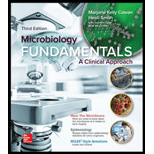
Concept explainers
Introduction:
Sometimes a pathogen develops resistance against a particular antimicrobial agent and sometimes pathogens develop resistance against a wide variety of antimicrobials. Some examples of multiple-drug-resistant strains of microbes are: Staphylococcus, Streptococcus, Enterococcus, Plasmodium and many others are resistant to more than two different type of antimicrobial agent. These multi-drug-resistant microbes are called as superbugs due to their ability to resist a wide range of antimicrobials.
Answer to Problem 1Q
Correct answer:
Enterobacteriaceae is on the CDC’s (center for disease control) “Urgent Threat” list because of its potential resistance to antibiotics. Therefore, option (d) is correct.
Option (d) is given as “Enterobacteriaceae”.
Explanation of Solution
Justify the reason for the correct statement:
One of the bacterial families which top the “urgent list” of infections on CDC is Enterobacteriaceae. Enterobacteriaceae is a carbapenem drug-resistant bacteria family. This bacterial family has developed resistant to almost all existing antibiotics making it most harmful pathogens.
Hence, option (d) is correct.
Justify the reasons for the incorrect statements:
Option (a) is given as “Staphylococcus saprophyticus”.
Staphylococcus saprophyticus the main causative agent of urinary tract infections, is not on the “urgent list” of CDC. Hence, it is a wrong answer.
Option (b) is given as “Trichomonas vaginalis”.
Trichomonas vaginalis causes the asymptomatic vaginitis infection in females. Trichomoniasis is a flagellated protozoan. It is not on the “urgent list” of CDC. Hence, it is a wrong answer.
Option (c) is given as “Herpesvirus”.
Herpesvirus is known to be resistant against some antiviral drugs but is not on the “urgent list” of CDC. Hence, it is a wrong answer.
Hence, options (a), (b), and (c) are incorrect.
Enterobacteriaceae is on the “urgent list” of CDC as this bacterial family is known to have developed resistance against most of the antibiotic drugs.
Want to see more full solutions like this?
Chapter 21 Solutions
Microbiology Fundamentals: A Clinical Approach
- 22. Which of the following mutant proteins is expected to have a dominant negative effect when over- expressed in normal cells? a. mutant PI3-kinase that lacks the SH2 domain but retains the kinase function b. mutant Grb2 protein that cannot bind to RTK c. mutant RTK that lacks the extracellular domain d. mutant PDK that has the PH domain but lost the kinase function e. all of the abovearrow_forwardWhat is the label ?arrow_forwardCan you described the image? Can you explain the question as well their answer and how to get to an answer to an problem like this?arrow_forward
- Describe the principle of homeostasis.arrow_forwardExplain how the hormones of the glands listed below travel around the body to target organs and tissues : Pituitary gland Hypothalamus Thyroid Parathyroid Adrenal Pineal Pancreas(islets of langerhans) Gonads (testes and ovaries) Placentaarrow_forwardWhat are the functions of the hormones produced in the glands listed below: Pituitary gland Hypothalamus Thyroid Parathyroid Adrenal Pineal Pancreas(islets of langerhans) Gonads (testes and ovaries) Placentaarrow_forward
 Comprehensive Medical Assisting: Administrative a...NursingISBN:9781305964792Author:Wilburta Q. Lindh, Carol D. Tamparo, Barbara M. Dahl, Julie Morris, Cindy CorreaPublisher:Cengage LearningBasic Clinical Lab Competencies for Respiratory C...NursingISBN:9781285244662Author:WhitePublisher:Cengage
Comprehensive Medical Assisting: Administrative a...NursingISBN:9781305964792Author:Wilburta Q. Lindh, Carol D. Tamparo, Barbara M. Dahl, Julie Morris, Cindy CorreaPublisher:Cengage LearningBasic Clinical Lab Competencies for Respiratory C...NursingISBN:9781285244662Author:WhitePublisher:Cengage- Essentials of Pharmacology for Health ProfessionsNursingISBN:9781305441620Author:WOODROWPublisher:Cengage





